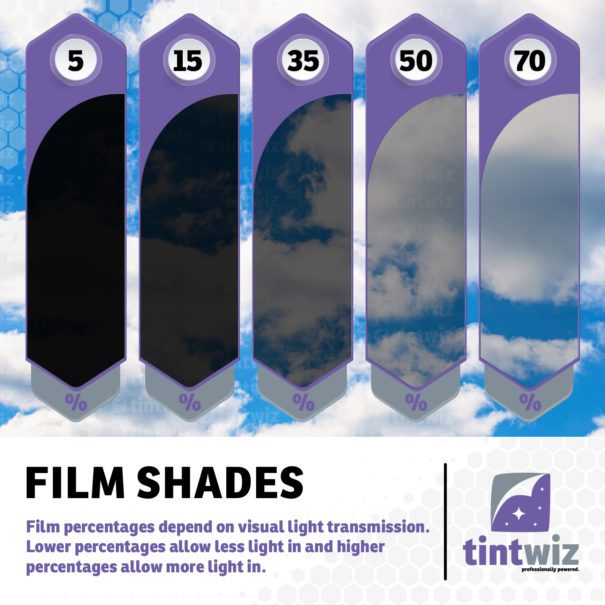Darkest legal tint for Sedans in Alaska
- Windshield: Non-reflective tint is allowed on the top 5 inches of the windshield
- Front Side windows: Must allow more than 70% of light in
- Back Side windows: Must allow more than 40% of light in
- Rear window: Must allow more than 40% of light in
Darkest legal tint for SUV and Vans in Alaska
- Windshield: Non-reflective tint is allowed on the top 5 inches of the windshield
- Front Side windows: Must allow more than 70% of light in
- Back Side windows: Must allow more than 40% of light in
- Rear window: Must allow more than 40% of light in
Table of contents
- Darkest legal tint for Sedans in Alaska
- Darkest legal tint for SUV and Vans in Alaska
- Can Alaska Drivers Tint the Windshield and Front Side Windows?
- Rear Window and Rear Windshield Tinting in Alaska
- 2020 Alaska Tint Laws Window by Window of Private Vehicles
- Window Film Reflectivity and Tint Colors Laws in Alaska
- Medical Exemptions for Alaska Window Tint Rules
- Window Film Certificates and Stickers in Alaska
- Penalties for Illegal Window Tint in Alaska
- The Benefits of Window Tint for Cars in Alaska
- How Dark Can You Tint Your Windows in Alaska?
- Alaska Window Tint Ticket Cost
Please note: The accuracy, completeness, adequacy or currency of the content is not warranted or guaranteed. We are not lawyers or a law firm and we do not provide legal advice. We recommend you consult a lawyer or other appropriate professional if you want legal advice.

Can Alaska Drivers Tint the Windshield and Front Side Windows?
Alaska’s window tint laws pertaining to vehicles are not complex but they are subject to change now and then, so having an up to date understanding of the state’s window tint laws is imperative if you already have aftermarket window tint on your car, truck, van, or SUV or if you are planning to add window film to a privately owned vehicle in Alaska.
Alaska window tint laws permit some window tinting on the windshield provided it meets certain parameters. The windshield may have a five-inch strip of tinting along the top of the glass provided the window film used is not reflective.
Side windows by the driver and front passenger seats may be tinted, but only to a maximum darkness of 70% VLT (Visible Light Transmission), which is a mild tinting. The tint will cut the glare of the sun, which can be harsh during the long days of an Alaska summer, and reduce the glare of headlights at night, so window tint makes driving safer and is a good idea. Just make sure the front side windows remain at 70% VLT especially if you are combining aftermarket tint with window tinting that was already in place.
Rear Window and Rear Windshield Tinting in Alaska
In Alaska, a vehicle may have 40% VLT window tint applied to any side windows other than those up front beside the driver and front passenger. This is true for five-seat sedans as well as for large multi-row SUVs or vans. The rear windshield may also be tinted to a darkness of 40% VLT.
While 40% Visible Light Transmission is not as dark a tint as is allowed by many states, it is still dark enough to provide a decent level of privacy, reducing the ability of people outside to see into the vehicle. This type of window tint does not perceptibly reduce the clarity of the view enjoyed by those passengers in the rear seats in the automobile.
All good car window film will block dangerous and damaging UV light and reduce amount of warm infrared light that gets into the cabin, even lighter or optically clear tints. So if you do not need a darker window tint for added privacy or style, there is no need for a dark window tint in order to enjoy the primary benefits.
2020 Alaska Tint Laws Window by Window of Private Vehicles
Unlike you will find in many states, tinting laws in Alaska apply equally to all types of vehicle, as in sedans, trucks, SUVs, and vans. Here is the breakdown of regulations for window tinting in Alaska in 2020:
One interesting thing to note about Alaska’s window tint for cars laws is that the state permits a slight variance. Your window tint can actually be as much as 3% VLT below the regulation (so 67% for front side windows and 37% for rear windows) without you being hit with an infraction. This is meant as a good faith measure that assumes your tint was not intentionally installed too dark – it should not be seen as an invitation to get darker tint.
Window Film Reflectivity and Tint Colors Laws in Alaska
To more effectively block glare that can make it harder to see the road and reduce heat that makes interiors too warm, many vehicle owners choose reflective window tint film that rejects more sunlight than non-reflective window tint (or simply glass windows alone), but the level of reflectivity is limited by Alaska tint laws. Check with your installer to make sure the window tint you are considering is not dark enough to violate window film reflection regulations.
As for window tint color in Alaska, you have several options. Window tint that is a shade of gray, green, bronze, or a neutral smoke color are all permitted, while other window tint colors are prohibited. Metallic or mirrored looks are prohibited, so make sure your window film is not shiny, especially if you opt for bronze colored window tint, as many vehicle window films in this metallic color do have a shiny finish.
Medical Exemptions for Alaska Window Tint Rules
In many cases Alaskans use window tint on their vehicles that would usually be illegal in order to mitigate medical issues. You must get a certifiable letter stating your need for special window tint from a physician licensed in Alaska in order to claim a medical window tint law exemption, and this exemption must be renewed annually by a physician. Common medical reasons for needing darker window tint than usually allowed by Alaska law include issues with the eye where bright light can be dangerous or damaging or skin issues, such as a history of or predilection to skin cancer.
Once you have your document proving you need a window tint medical exemption, present it to a licensed window tint installation shop in Alaska and you can work with your installer to get the right type of window tint for your vehicle based on your medical needs.
Window Film Certificates and Stickers in Alaska
Alaska puts most of the responsibility for following window tint laws in the hands of the people, meaning both window tint manufacturers, vendors, and installers as well as the people who choose to get window tinting for their vehicles. Tint manufacturers and sellers are not required to specifically certify any window films they offer as meeting state rules, they simply are expected to do so.
Likewise, a driver with tinted windows is not required to keep paperwork proving their tint is legitimate nor must they have stickers on the tinted windows that display the type and VLT of the tint. If you have a tint darker than permitted by law thanks to a medical exemption, it is a good idea to keep a copy of the physician certified document in your vehicle, however.
Penalties for Illegal Window Tint in Alaska
As with the non-severe approach to legal window tint certification and documentation, Alaska laws are generally non-severe when it comes to enforcement of window tint rules as well. An infraction against window tint regulations carries a $300 fine plus a $10 surcharge, but this is currently only the case if you cannot prove that you get your illegal window tint removed within a specified period of time. Thus getting caught with illegal window tint may result in nothing worse than you needing to get that tint removed and, if you wish, replaced with a window tint that meets Alaskan law.
That said, that $300 fine is much higher than you would pay for a first window tint violation in other states, where the first infraction can cost as little as $25. (Of course some states reserve the right to send a person to jail for violating car window tint laws.)
The Benefits of Window Tint for Cars in Alaska
Window tint in Alaska is well worth the cost of its installation and in most cases will pay for itself over the course of several years. It does this in several ways. First, window tint blocks the amount of hot infrared light that gets into the car, keeping it cooler and meaning less use of fuel-burning AC during the summer. It also adds insulation that can help keep the car warmer in winter.
But it is the ultraviolet light blocking properties of window tint that make it one of the best investments you can make. Window tint blocks 99% of the sun’s UV light, so the fading, cracking, and peeling so commonly seen on upholstery, dashboards, and other surfaces in your car will be prevented, leaving the car looking great for years and ensuring your vehicle maintains resale value. This is especially important given the long sunny days in the summer in Alaska.
When it comes time to sell a car, truck, van, or SUV, the window tint that protected the interior against damage will pay for itself many times over.
The National Highway Safety Traffic Administration (NHTSA) sets the standard for automobile manufacturers as it relates to the tinting or glazing of windows [Federal Motor Vehicle Safety Standard No. 205, Glazing Materials (49 CFR §571.205)].
A provision in Standard No. 205 requires a minimum of 70 percent light transmittance in any glazing area requisite for driving visibility.
The percent of visible light allowed through your car windows is called VLT: Visible Light Transmission. The percentage of light allowed through your film and glass in Alaska is very specific and different for passenger car such as a sedan vs a multi-purpose passenger and recreational vehicle. The lower the % of the tint, the darker your window will be as the VLT is referring to the amount of light being let in.
Please note: The accuracy, completeness, adequacy or currency of the content is not warranted or guaranteed. We are not lawyers or a law firm and we do not provide legal advice. We recommend you consult a lawyer or other appropriate professional if you want legal advice.
How Dark Can You Tint Your Windows in Alaska?
If you have ever traveled on Anchorage roads, you have probably seen it – a vehicle with darkly tinted windows. It may cause you pause, or may even have you consider applying tinted film on your own vehicle windows. Whether you may want to control glare, provide privacy, or enhance your vehicle’s appearance; there are important safety facts and tips to consider:
The National Highway Safety Traffic Administration (NHTSA) sets the standard for automobile manufacturers as it relates to the tinting or glazing of windows [Federal Motor Vehicle Safety Standard No. 205, Glazing Materials (49 CFR §571.205)]. A provision in Standard No. 205 requires a minimum of 70 percent light transmittance in any glazing area requisite for driving visibility.
Question: What is the legal limit for tinted windows in Alaska?
Answer: 70 percent – Under Alaska law, window tint must allow at least 70 percent light transmittance in the front side windows and at least 40 percent in the rear windows.
Exceptions are granted for people who for medical reasons need to be shielded from the sun.
The primary purpose of this requirement is to ensure adequate visibility through the vehicle’s windows, thereby reducing the risk of a motor vehicle crash. In passenger cars, almost all windows are considered requisite for driving visibility.
In trucks and multipurpose vehicles like some vans or sport utility vehicles (MPVs are designated by manufacturer and usually posted near the VIN), the rear and rear side windows (rearward of the “C” pillar) are considered not requisite for driving visibility and therefore come from the manufacturer with privacy glass or windows darker than the minimum of 70 percent light transmittance.
It is illegal in the State of Alaska (13 AAC 04.223) and within the Municipality of Anchorage (AMC 09.36.045) to have mirrored tinting material or aftermarket tint on any of your windows with the following exceptions:
The glass immediately in front of the driver may have a strip of tinting material applied to the top edge, known in the industry as “eyebrow,” which does not extend downward more than five inches from the top of the glass.
The windows immediately to the driver’s right and left may have tinting material that permits at least 70 percent light transmittance.
The rear door windows, quarter glasses, and back glasses may have tinting material that permits at least 40 percent light transmittance.
Limousines and passenger buses used to transport persons for hire, motor homes and vehicles identified by the vehicles manufacturer as multipurpose may have tinting material that complies with Standard No. 205, Glazing Materials, in 49 C.F.R. 471.205/571.205 (1992).
The windows of a vehicle may have tinting material that permits less light transmittance than that specified if the driver or passenger who frequently travels in the vehicle is required for medical reasons to be shielded from the direct rays of the sun, the medical reasons are certified annually by a physician licensed to practice in this state, and the certification is carried in the vehicle.
Consider the 70 percent light transmittance requirement; most new vehicles today have the front windshield, and the front driver or front passenger windows at or just above the specified requirement. Therefore, any film tint added will most likely make your front windows illegal. If you are considering having your windows tinted, or, if you own a vehicle with tinted windows please keep in mind that during the early morning and evening hours (especially in the fall or winter months), it is most important to be able to have maximum visibility out of your windows.
Bottom line – if you keep your vehicle in factory condition by not adding tint film and keep your windows clean and free of obstructions, you will maximize your visibility and reduce the chance of a collision. You will also reduce the chance of being stopped and cited.
The Anchorage Police Department primarily enforces the municipal ordinance for tinted windows.
Alaska Window Tint Ticket Cost
Violations are considered correctable or “fix it” traffic offenses. The citation will indicate zero points, with a $300 fine and $10 surcharge if the deficiency is not corrected within a specified amount of time. The corrected vehicle and copy of the citation must be taken to APD Headquarters where a tint meter will be used to confirm the correction.









